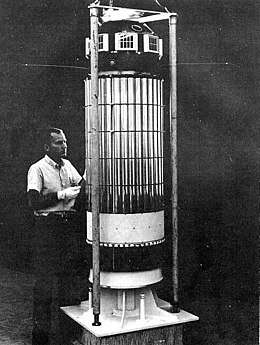Explorer 13
 Explorer 13 (S-55A) | |||||||||||||
| Operator | NASA | ||||||||||||
|---|---|---|---|---|---|---|---|---|---|---|---|---|---|
| Harvard designation | 1961 χ1 | ||||||||||||
| COSPAR ID | 1961-022A | ||||||||||||
| SATCAT no. | 180 | ||||||||||||
| Website | 1961-022A[1] | ||||||||||||
| Mission duration | 3 days | ||||||||||||
| Spacecraft properties | |||||||||||||
| Manufacturer | GSFC | ||||||||||||
| Launch mass | 86 kg (190 lb) | ||||||||||||
| Start of mission | |||||||||||||
| Launch date | August 25, 1961, 19:26 UTC[2] | ||||||||||||
| Rocket | Scout X-1 | ||||||||||||
| Launch site | Wallops LA-3 | ||||||||||||
| End of mission | |||||||||||||
| Last contact | August 28, 1961 | ||||||||||||
| Orbital parameters | |||||||||||||
| Reference system | Geocentric | ||||||||||||
| Regime | Low Earth | ||||||||||||
| Eccentricity | 0.07392[1] | ||||||||||||
| Perigee | 125 km (78 mi)[1] | ||||||||||||
| Apogee | 1,164 km (723 mi)[1] | ||||||||||||
| Inclination | 37.7°[1] | ||||||||||||
| Period | 97.5 minutes[1] | ||||||||||||
| Epoch | August 25, 1961[1] | ||||||||||||
| Instruments | |||||||||||||
| |||||||||||||
Explorer 13 (also called S-55A) was an American satellite launched as part of Explorers program. Was launched on August 25, 1961 from Wallops Flight Facility, Virginia, U.S..
Mission
Explorer 13 was injected into a geocentric orbit of moderate eccentricity using a Scout launch vehicle. The objectives of the flight were to test vehicle performance and guidance and to investigate the nature and effects of micrometeoroids on the spacecraft systems. The scientific instrumentation consisted of cadium sulfide-cell, wire-grid, piezoelectric, pressurized-cell, and foil-type micrometeoroid detectors.
The spacecraft was a 1.93 m × 0.61 m (6.3 ft × 2.0 ft) cylinder. The orbit was lower than planned, and the spacecraft reentered the atmosphere on August 28, 1961, after only slightly more than 2 days in orbit. No penetrations were recorded by this satellite during experiment operations. This aided in determination of useful flux limits for subsequent experiment design.
References
.png)